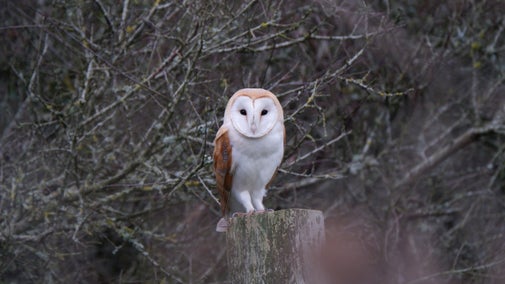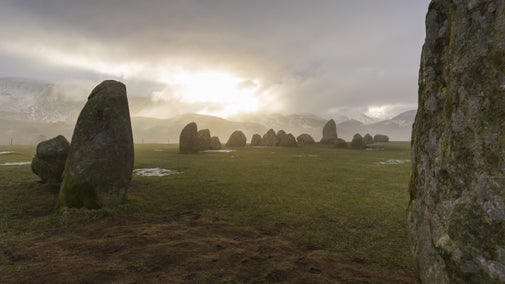Our work in Borrowdale

There is no such thing as a typical day when it comes to work in the Borrowdale Valley – rangers could be doing anything from path maintenance to repairing gates, planting trees and hedge laying, helping researchers in the Oak Woodlands or designing conservation projects. Working together with farm tenants and volunteers, find out how we’re not only protecting this special place, but helping it to thrive too.
Woodland Management
The ancient temperate rainforest in Borrowdale was once part of a very large forest that stretched from western Scotland all the way down the west coast of Britain and Wales. Today this great woodland has been reduced to small, isolated fragments with the largest remaining being in Borrowdale. The woods in this valley are one of the most important habitats in Europe for mosses and liverworts (bryophytes), and lichens – especially 'old forest species'. As a result of their rarity and diversity, the Borrowdale rainforest is protected as Sites of Special Scientific Interest (SSSI) and has recently been declared a new National Nature Reserve.
Such an important natural site in a popular tourist destination and within a farming community requires a lot of effort to maintain and protect but even more so since we are also looking to reconnect parcels of woodland and improve its overall health health. Strong, well maintained boundaries are then all the more vital.
Path maintenance to help ensure visitors can enjoy the outdoors while remaining on the trails also helps protect precious undergrowth from trampling and mosses and lichens from getting rubbed off trees. Since some of these woodlands are not yet in a fully self-sustaining state due to past over grazing etc, other woodland management techniques are also used to help create a more diverse and robust forest. Our foresters and rangers use coppicing to let more light in, creating rides and scallops, increasing biodiversity of the flora, age diversity in the trees and creating more space for mature trees growing in these areas.
The teams are also replanting areas with hardy native trees, often from seeds gathered right here in Borrowdale, to reconnect the woodlands, create wildlife corridors and increase biodiversity while ensuring it will be resilient to climate change.
Red squirrel conservation
As part of our countryside stewardship work, the ranger team are monitoring the health of our red squirrel population in Borrowdale. We have cameras set up in a few locations near feeders so we can catch these illusive treetop animals as they come down for a snack. This also means keeping an eye on grey squirrel numbers.

Looking after our boundaries
Whether it be mending fences, hanging gates, fixing hecks and dry stone walls or maintaining and adding hedgerows, looking after our boundaries is an important task which requires hard work and skill. Not only do these features need to perform their function well, they also need to stay in keeping with the traditional style of this special part of the world. Even hedgerow types will vary from county to county and require specialist knowledge to do right. These culturally significant living walls also need to benefit wildlife and livestock as much as possible so the right native trees, shrubs and other plants need to be selected to provide as much food and shelter as possible. This is why we have been planting more and more "edible" hedges rich in pollen, fruits and nuts which can also provide foraging sites for local people.
All boundaries of course help to keep livestock safe while ensuring our woodlands remain protected from overgrazing, ensuring saplings and undergrowth have a chance to grow. This is why both enclosures and sometimes exclosures are needed, especially when we are looking to establish new wooded areas particularly susceptible to sheep or deer.
Our rangers and volunteers walk for miles to look after these boundaries and it is an ongoing job that will always need done.
Build Our Boundaries team
With the temporate rainforest in need of extra protection, the Build Our Boundaries team of rangers was brought together in 2023 to survey and repair the boundaries in this precious area. Their efforts are already making a difference in keeping livestock out of the woodlands and allowing for natural regeneration.

Renewable energy in Borrowdale
Where there is an abundance of water, there is the potential for an abundance of renewable energy. In the notoriously wet Lake District, this concept certainly isn’t a new one since its history of water powered mills can be traced back to the medieval period. Over the last few years we have established 3 hydro's in the Borrowdale Valley; Coombe Gill, Hause Gill and the latest one in the little hamlet of Watendlath.
Hydros are a wonderful way of harnessing renewable energy while looking after the river eco-system and wildlife. Since they do not require the watercourse to be dammed, they don’t cause surrounding areas to flood nor do they stop fish and other animals from moving freely down the watercourse. Ensuring there is always flow in the river, only a set amount of water is extracted to power the turbine and that may be stopped completely during dry spells. The pipes that direct this extra water are all hidden underground along the banks to make sure the natural riparian habitat, and its beauty, remains intact. The rangers look after our hydros, cleaning the intake of leaves and branches, adjusting the flow in the turbines and making any necessary repairs.
The Watendlath Hydro is the 11th to be installed in the whole of the Lake District over the last 8 years, making use of the large amount of rain fall and the many gills, becks and rivers that criss-cross the countryside. The new turbine produces 200,000 kWh of energy per year which is approximately enough power for the yearly needs of 70 houses. All told, our hydro units will produce approximately 5,788,000 kWh per year which represents the annual electricity needs of almost 2000 houses! This energy feeds directly back to the National Grid and will help in our ambition to be net carbon neutral by 2030.

Increasing accessibility
As part of our Everyone Welcome priority, we are looking to increase accessibility in Borrowdale to make sure more people are able to enjoy nature, beauty and history.
We are working with disability advocates and experts to identify places where we can make the biggest difference and hope to be able to provide a path with lakeside mountain views as well as a chance for some peaceful forest bathing. In other words, an ideal location for everyone to experience the Lakes.
We are also finding ways to improve the accessibility of our paths, alterations such as creating ramps or alternate routes, changing gates, smoothing out surfaces and having more specific route information available so people can better prepare for their day out.

Supporting visitors
Answering visitors’ questions and helping them get the most out of their day is a key part of what we do which is why you will often find our helpful welcome team braving all weathers to greet you in our car parks. Maintaining paths, improving accessibility, organizing events and looking after facilities such as our toilet blocks are just a few other ways we try to make sure you are able to enjoy your visit to this special place.
Unfortunately we also have to deal with a minority who come to spend a weekend in the Lakes without following the countryside code. Some fly camp or stay overnight outside of designated caravan sites and end up leaving human waste as well as large amounts of litter to be picked up by the team. Some also obstruct or even damage farmer’s gates, cut down trees, make fires and leave broken glass on the lakeshore. Cleaning up and repairing damage takes the rangers away from important conservation work but luckily these are the exception to the rule and most visitors are quick to help us look after the landscape.
Please do stop to say hi to any members of the team while out and about, we love to hear from you!

River conservation
The Derwent Water catchment includes rivers and tributaries, wetlands, peatlands and more in a complex system of water which ebbs and flows in the wettest area in England. In recent years, we have seen an increase in extreme weather which has meant droughts that have seen the River Derwent run dry along with flooding events in the wetter months. The Riverlands team has been working to help make the rivers here more resilient to climate change while adding much needed habitat for our wildlife.
Many of the waterways here have been modified over the years which brings water away from the landscape quickly and has caused the loss of many of our wetland areas. Derwent Riverlands has been adding ponds, rewinding rivers, monitoring river levels and restoring peatlands and we have begun to see the positive effects of their efforts. To learn more about the Derwent River Project, follow this link.
Volunteer with us
Search for live volunteering opportunities to help us look after the landscape, or register your interest with Borrowdale and Derwent Water.

Wildlife in Borrowdale and Derwent Water
Discover the internationally significant ‘Atlantic oakwoods’ and Derwent Water which support a variety of rare species of plants and animals, including the red squirrel and vendace.

Things to see and do in Borrowdale
Discover the top things to see and do during your visit, including scenic walks, ancient woodlands, far-reaching views and famous Lakeland highlights such as the Bowder Stone

History in the Borrowdale valley
The Bowder Stone, Borrowdale Yews and Castlerigg stone circle have stood watching the Borrowdale valley evolve around them. Discover the history of these ancient residents.

What is coppicing?
Coppicing is an ancient woodland management technique that was once used to ensure a regular supply of timber and firewood. Discover how it's used today at the places we care for to create a range of habitats for plants and wildlife.

Car parks in Borrowdale and Derwent Water
There are nine National Trust car parks in Borrowdale and Derwent Water to choose from. Find out how to find them and how much parking costs.

Walla Crag to Ashness Bridge walk
This walk takes you through the timeless beauty of the Borrowdale landscape and up to magnificent viewpoints which are spectacular in every season.

Farming in the Lake District
Learn about the traditional farming practices in the Lake District and how the National Trust works with farm tenants to restore vital habitats, protect wildlife and support quality local produce.
